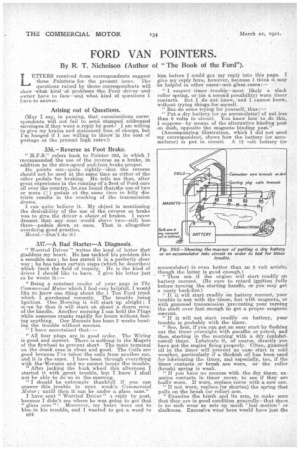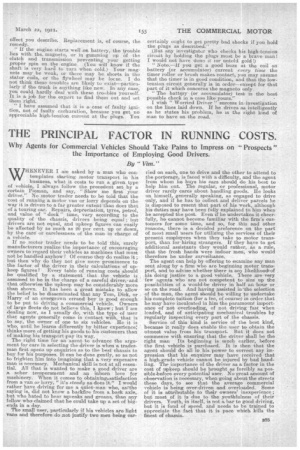FORD VAN POINTERS.
Page 28

Page 29

If you've noticed an error in this article please click here to report it so we can fix it.
By R. T. Nicholson (Author of "The Book of the Ford").
LETTERS received from correspondents suggest three Pointers. for the present issue. The questions raised by those, correspondents will show -what kind' of problems the Ford driver and owner have to face—and what kind of questions I have to answer.
Arising out of Questions, that (May I say, in. passing, at conscientious corre spondents will not fail to send stamped addressed envelopes if they want a reply by post.1 I am willing to give my brains and stationery free. of charge, but I'M hanged if I am willing to throw in the cost of postage at the present high rates!) 4 •
336.—Reverse as Foot Brake.
" H.F.S." refers back to Pointer 329, in which I recommended the use of the reverse as a brake, in addition to the slow-speed and-foot brake proper.
He points out—quite rightly—that the reverse should not be used at the same time as either of the other pedals 'for braking. He, tells me that, after great experience in the running ofa fleet of Ford cars all over the country, he.nas found thatobhe use of two or more ( I ) pedals at the same time in hilly districts results in the cracking 0.f the transmission drums.
I can quite believe it. My object in mentioning the desirability of the use of the reverse as brake was to give the driver a choice of brakes. I never dreamt that any man would shove two—still less three—pedals down at once. That is altogether overdoing good practice. Moral.—Don't do it
337.—A Bad Starlet—A Diagnosis.
" Worried Driver " writes the kind of letter that gladdens my heart. He has tackled his problem like a sensible man ; he has stated it in a perfectly clear way ; he has taken certain steps (which he describes) which limit the field Of inquiry. He is the kind of driver I should like to have. I give his letter just as he wrote it:
" Being a constant reader of your page in The Commercial Motor which I find very helpfull, I would like to know one thing about the 1 Ton Ford truck which I purchased recently. The trouble being Ignition. One Morning it. will start up alright;; imian by that it will start on about a dozen revs.• of the handle. Another morning I can hold the Plugs while someone cranks rapidly for hours without feeling anything. Our Mecanic has been 8 weeks locating the trouble without success.
I-have accertained that :—
"All four plugs are in good order. The Wiring is good and correct. There is nothing in the Magets of the flywheel to prevent short, The main terminal on the crank case is de-an and Food. The Coilsare good because I've taken‘the coils from another ear, and it is the same. I have been through everything with theelleeanic and we cannot locate the, trouble. Aftei jacking the back wheel this afterneon I started it with great trouble, but I know I shall not be able to do' so in the • morning.
"I should be extremely thankfull ifyou can answer this trouble in next week's Commercial Motor; • until] then it can be under a glass case."
I have sent " Worried Driver" a reply by post, because I didn't see where he was going to get that " glass case " .Moreover, my heart went out to bimeirt his trouble, and I wanted to get a word to B24 him before I could get my reply into this page. I give my reply here, however, because I think it may be helpful in other cases—not glass cases:—
" I suspect timertrouble—most; likely a slack roller sprin.g, or (as a second possibility) worn timer contacts. But I do not know, and I cannot know, without trying things for myself.
" But do some trying for yourself, thus:—
" Put a dry battery (or an accumulator) of not less than 8 volts, in circuit. You know how to do this, I suppose—by means of the alternative binding post on dash, opposite the magneto binding post."
(Accompanying illustration, which I did not send my correspondent, shows how the battery (or accumulator) is put in circuit. A .12 volt. battery (or accumulator) is even better than an 8 volt article, though the latter is good enough.)
" Then see if the engine will start readily on battery current. (Be sure to retard ignition fully before turning the starting handle, or you may get a nasty back-fire.)
" If it will start readily on battery current, your trouble-is not with the timer, but with magneto, or with gummed transmission preeenting your turning the shaft over fast enough to get a proper magneto current.
" If it will not start readily On battery, your trouble is probably with the timer.. • " See, first, if you can get an easy start by flushing out the timer overnight with paraffin or petrol, and then starting in the morning with a dry (unlubricated) timer. Lubricate it, of' course, directly you have. got the engine firing properly. Often, gummed oil in the timer will prevent an easystart in cold weather, particularly if a thickish oil has been used for lubricating the timer, and especially, too, if the timer contacts or brush are worn, -or the roller (brush). spring is weak. "If you have no success with .the dry timer, examine contacts in timer eta-vier, to see if they are badly worn. If worn, replace cover with a new one.
"If not worn, replace (or shorten) the spring that pulls on the brush (or roller) arm. "Examine the brush and its arm, to make sure that they are in good condition generally—that these. is no such wear as sets up much 'lost motion or slackness. Excessive wear here would have just the effect you describe. Replacement is, of course, the remedy.
" If the engine starts well on battery, the trouble lies with the, magneto, or in gumming up Of the clutch and transmission preventing your getting proper spin on the engine. (You will know if the shaft is very hard to turn when cold.) Your magnets may be weak, or theremay be shorts in the stator coils, or the flywheel may be loese. I do not think these troubles are likely to exist—particularly if the truck is anything like new. In any case, you could hardly deal with these troubles yourself. It is a job for the expert to find them out and eet them right.
"I have assumed that it is a, case of faulty ignition, not of faulty carburation, because you get no appreciable high-tension current at the plugs. You certainly ought to get pretty bad shocks if you hold the plugs as described." But any inveetigater who checks his high-tension circuit by holding the plugs must be a brave man! I would not have done it tor untold gold!)
"Note.-1f you get a good buzz at the coil on battery (or accumulator) current euery time the timer roller or brush makes contact, you may assume that the timer is in good condition, and that the lowtension circuit generally is in order—except for that part of it which concerns the magneto only.
" The battery (or accumulator) test is the best possible cheek in a ease like yours."
I wish " Worried Driver" success in-investigation on the lines laid down. If he drives as intelligently as he states his problem, he is the right kind of man to have on the read.
































